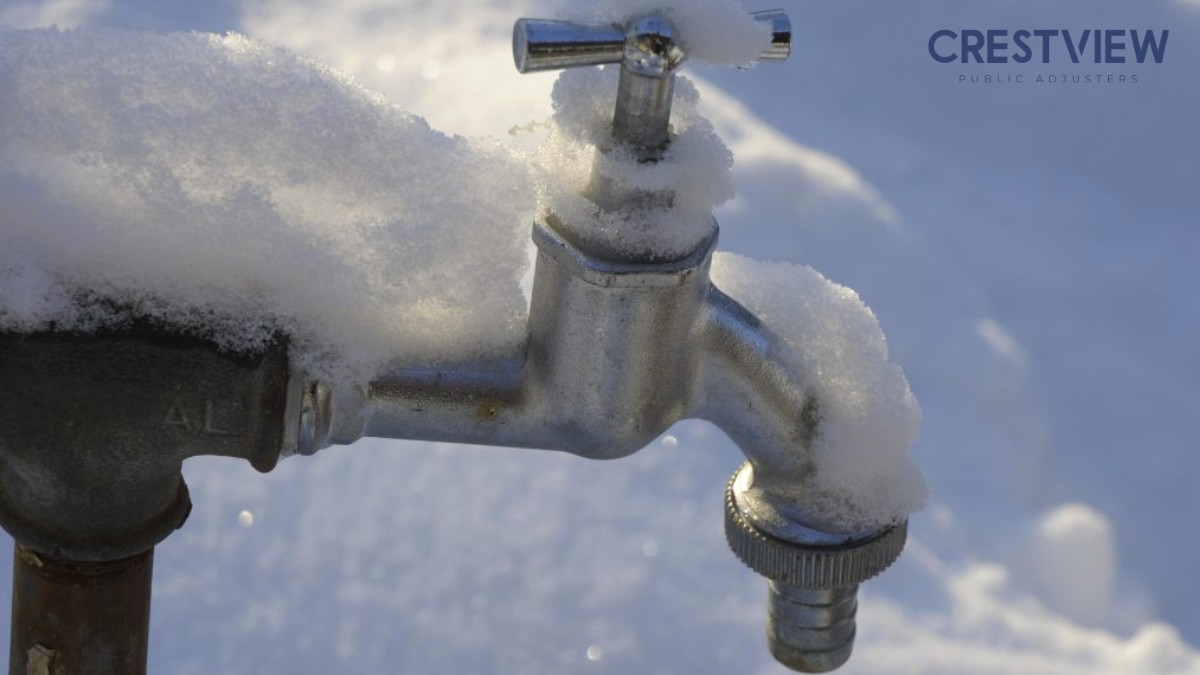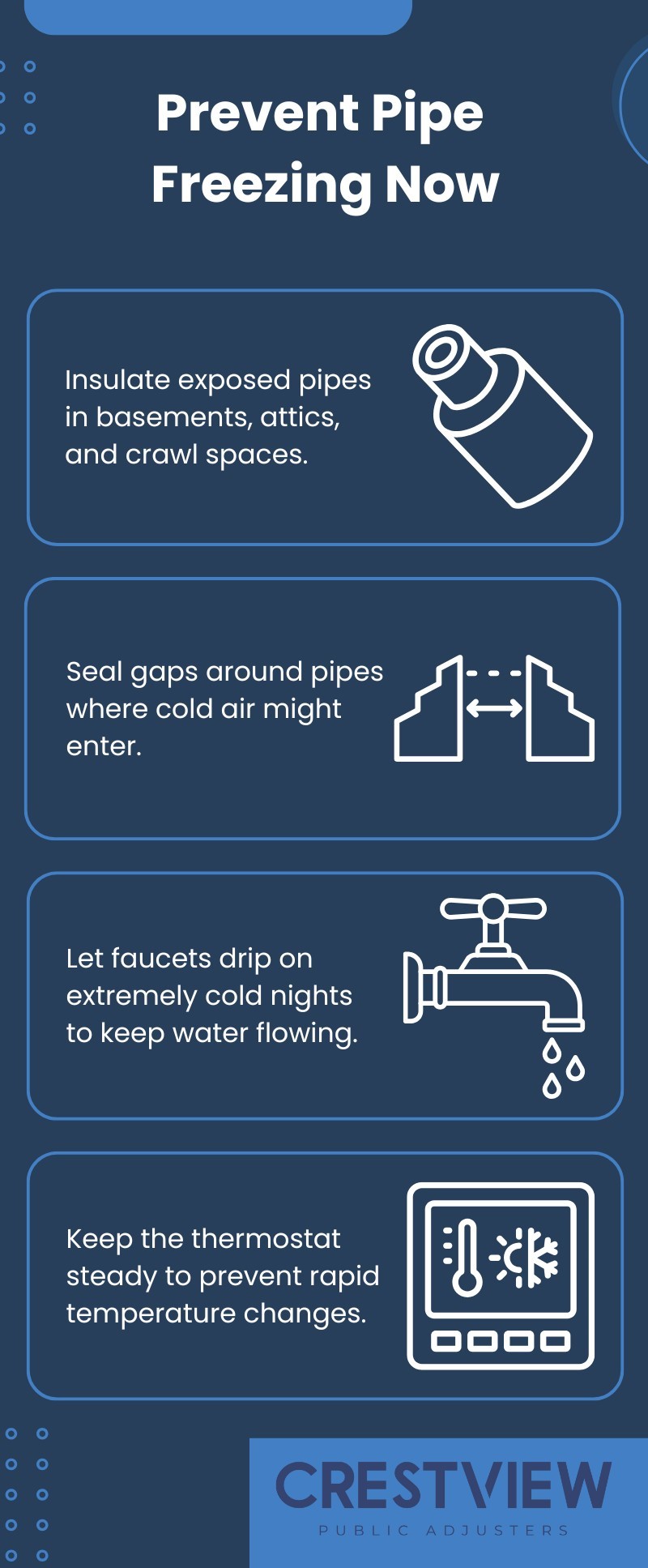Key Points:
- Frozen pipes can lead to costly water damage and major plumbing issues if not detected early.
- Common warning signs include reduced water flow, visible frost on pipes, and unusual smells from drains.
- Immediate action, such as applying heat or shutting off the main water supply, can prevent pipes from bursting.
Frozen pipes can be detected early by recognizing signs such as weak water pressure, frost buildup on pipes, and strange odors from your faucets or drains. If these warning signs go unnoticed, they can lead to burst pipes, severe water damage, and expensive repairs. During extreme cold, especially in areas with fluctuating winter temperatures, being proactive can save homeowners from a major disaster.
How Do Frozen Pipes Happen?
Pipes freeze when the water inside them reaches 32°F (0°C) or lower. As water turns into ice, it expands, putting immense pressure on the pipe walls. If the ice blockage becomes severe, the pipe can rupture, leading to significant leaks and flooding.
Certain conditions increase the risk of frozen pipes, including:
- Poor insulation – Pipes in unheated areas, like basements, crawl spaces, and attics, freeze faster.
- Sudden temperature drops – A sharp drop in temperature can cause pipes to freeze overnight.
- Little water movement – If faucets are not used regularly, stagnant water inside the pipes can freeze more quickly.
Common Frozen Pipe Signs to Watch For
1. Reduced or No Water Flow
One of the first indicators of a frozen pipe is a sudden drop in water pressure. When turning on a faucet, you may notice only a small trickle or no water at all. This happens because ice is blocking the flow, preventing water from reaching your fixtures.
- If only one faucet is affected, the frozen section is likely nearby.
- If multiple faucets have low pressure, the issue could be within the main supply line.
- Pipes along exterior walls or in unheated areas are often the first to freeze.
A lack of water in cold weather should never be ignored. If left untreated, the blockage can expand and lead to a pipe burst.
2. Frost on Pipes
If you have exposed pipes in your basement, garage, or under sinks, check them for frost. When temperatures drop, condensation can freeze on the outside of the pipe, creating a layer of frost.
- Frost is a warning that the pipe’s interior is nearing freezing temperatures.
- Pipes with frost on them should be warmed immediately to prevent full blockage.
- Insulating exposed pipes can help prevent future freezing.
Checking pipes in vulnerable areas before extreme cold hits can save you from unexpected plumbing failures.
3. Unusual Odors Coming from Faucets or Drains
A strange smell coming from your sink, bathtub, or any drain could indicate a frozen pipe. Normally, plumbing systems allow sewer gases to escape, but if a pipe is blocked by ice, those gases can get trapped and back up into your home.
- Foul odors, especially in multiple drains, can signal a blockage in your main line.
- If the smell is only in one drain, the affected pipe may be a smaller branch line.
- A frozen pipe affecting drainage can eventually lead to cracks and leaks.
If you notice a strong sewage or musty smell, inspect pipes for frost or listen for other signs of ice blockage.

4. Unusual Noises from Pipes
Pipes that are starting to freeze may produce strange noises, such as:
- Banging or clanking sounds – Expanding ice can cause pressure buildup, leading to loud knocking noises.
- Gurgling or bubbling – Air pockets trapped due to ice can create gurgling sounds when you turn on the faucet.
- Whistling or high-pitched sounds – Narrowed water passageways may force water through at higher pressure, causing whistling noises.
If your pipes are making unfamiliar sounds in cold weather, investigate immediately to avoid further complications.
5. Bulging or Cracked Pipes
Even if a pipe hasn’t completely burst, ice expansion can cause visible bulging or hairline cracks. This is especially common in older pipes or those made of rigid materials like PVC or copper.
- A bulging section of a pipe is a major warning sign that a rupture is imminent.
- Even small cracks can result in leaks when the ice thaws.
- Pipes showing visible damage should be replaced before they fail completely.
Checking pipes regularly during winter can prevent costly damage before it happens.
What to Do If You Suspect Frozen Pipes
If you’ve noticed any frozen pipe signs, act quickly to prevent a burst pipe:
- Turn on faucets – Running even a small trickle of water can help relieve pressure and reduce the chance of a full freeze.
- Apply gentle heat – Use a hairdryer, heating pad, or space heater to slowly warm frozen pipes. Avoid open flames.
- Open cabinet doors – If indoor pipes are affected, opening cabinets can help warm them with room air.
- Shut off the main water supply – If a pipe is completely frozen or leaking, turn off the water to prevent further damage.
- Call a professional – If you cannot locate or safely thaw the frozen section, a plumber or public adjuster can help.
Preventing Frozen Pipes in the Future
Homeowners can take steps to avoid frozen pipes before winter arrives:

Regular maintenance and early prevention can significantly reduce the risk of frozen pipes.
Get Help with Winter Damage Claims – Contact Crestview
Frozen pipes can lead to significant property damage, and dealing with insurance claims can be overwhelming. If your home has suffered from water damage due to a burst pipe, Crestview’s expert public adjusters can help you navigate the claims process and maximize your settlement.
We specialize in winter damage claims across New Jersey, New York, and Florida, ensuring that homeowners get the compensation they deserve. Don’t let your insurance company undervalue your claim—contact Crestview today to get the support you need.

